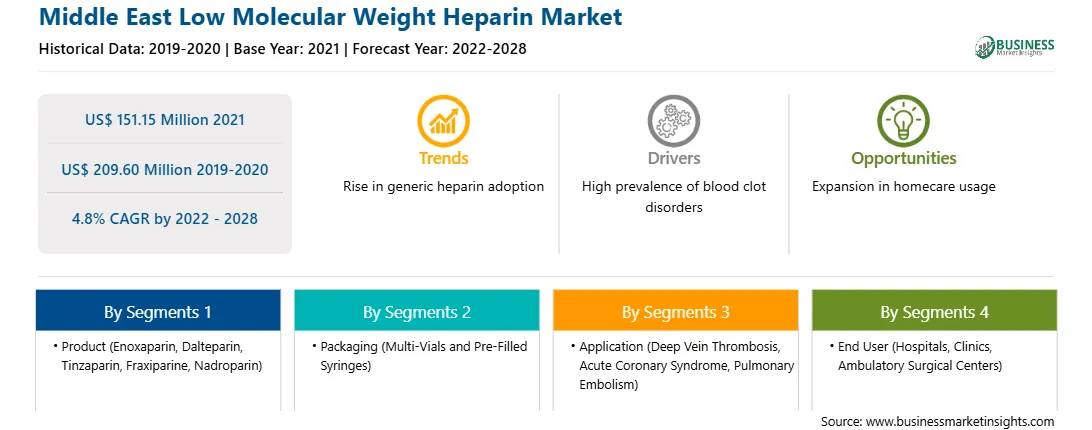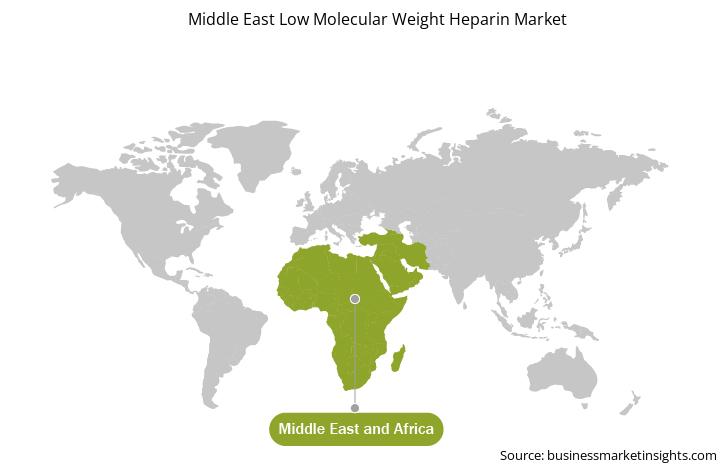The Middle East low molecular weight heparin market is expected to grow from US$ 151.15 million in 2021 to US$ 209.60 by 2028. It is estimated to grow at a CAGR of 4.8% from 2022 to 2028. The report highlights prevailing trends and factors driving the market growth.
The growth of the Middle East low molecular weight heparin market is attributed to the advantage of low molecular weight heparin anticoagulant over unfractionated heparin However, the adverse effect of low molecular weight heparinis hindering the overall market growth.
Low molecular weight heparin (LMWH) is a class of anticoagulants. They are used to prevent blood clots and treat venous thromboembolism (deep vein thrombosis and pulmonary embolism) and treat myocardial infarction. LMWHs are defined as heparin salts with an average molecular weight of less than 8,000 Daltons and in which at least 60% of all chains have a molecular weight of less than 8,000 Da. These are obtained by various methods of fractionation or depolymerization of polymeric heparin. Low molecular weight heparin offers advantages over heparin such that it has better bioavailability and longer half-life, simplified dosing, predictable anticoagulant response, and lower risk of osteoporosis.
Strategic insights for the Middle East Low Molecular Weight Heparin provides data-driven analysis of the industry landscape, including current trends, key players, and regional nuances. These insights offer actionable recommendations, enabling readers to differentiate themselves from competitors by identifying untapped segments or developing unique value propositions. Leveraging data analytics, these insights help industry players anticipate the market shifts, whether investors, manufacturers, or other stakeholders. A future-oriented perspective is essential, helping stakeholders anticipate market shifts and position themselves for long-term success in this dynamic region. Ultimately, effective strategic insights empower readers to make informed decisions that drive profitability and achieve their business objectives within the market. The geographic scope of the Middle East Low Molecular Weight Heparin refers to the specific areas in which a business operates and competes. Understanding local distinctions, such as diverse consumer preferences (e.g., demand for specific plug types or battery backup durations), varying economic conditions, and regulatory environments, is crucial for tailoring strategies to specific markets. Businesses can expand their reach by identifying underserved areas or adapting their offerings to meet local demands. A clear market focus allows for more effective resource allocation, targeted marketing campaigns, and better positioning against local competitors, ultimately driving growth in those targeted areas.
Middle East Low Molecular Weight Heparin Strategic Insights

Middle East Low Molecular Weight Heparin Report Scope
Report Attribute
Details
Market size in 2021
US$ 151.15 Million
Market Size by 2028
US$ 209.60 Million
Global CAGR (2022 - 2028)
4.8%
Historical Data
2019-2020
Forecast period
2022-2028
Segments Covered
By Product
By Packaging
By Application
By End User
By Distribution Channel
Regions and Countries Covered
Middle East and Africa
Market leaders and key company profiles
Middle East Low Molecular Weight Heparin Regional Insights

Advantages of Low Molecular Weight Heparin Anticoagulants over Unfractionated Heparin
The effects of unfractionated heparin (UFH) or standard heparin vary from patient to patient. Therefore, it can only be administered to hospitalized patients under supervision. However, low molecular weight heparins (LMWH) can be subcutaneously administered daily without supervision. In addition, LMWH has predictable pharmacokinetic properties to unfractionated heparin, which allows its administration in fixed doses based on laboratory monitoring without needing dose adjustments. The low molecular weight fractions of heparin have a molecular weight of ~3,500–8,000 Dalton while unfractionated heparin has a molecular weight of 15,000 Daltons; thus, the former reacts less with platelets than the latter.
Moreover, LMWH is less likely to induce immune allergic thrombocytopenia, which is a severe side effect caused by unfractionated heparin (UFH). This side effect is often complicated for patients suffering from arterial thrombosis. In addition, properties such as better bioavailability, predictable dose-response, and longer plasma half-life than unfractionated heparin make LMWH a preferred choice for anticoagulation therapy.
LMWH anticoagulants prevent the clotting of blood and the growth of existing blood clots in blood vessels. In recent years, the development of prevention methods and pharmacological and surgical treatment of thrombosis have improved considerably. LMWHs have been used in the treatment of antithrombotic diseases for the past two decades. LMWH exhibits anticoagulant properties such as antitumor, anti-inflammatory, and antiproliferative effects, which are useful in the treatment of pathologies such as nephrotic syndrome and Alzheimer's disease. Thus, the advantages of LMWH anticoagulants over unfractionated heparin are driving the Middle East low molecular weight heparin market.
Impact of COVID-19 Pandemic on Middle East Low molecular weight heparin Market
In the past several decades, countries in the Middle East have strengthened their health systems, along with upgrading public and commercial healthcare. However, the limited availability of resources (including trained staff and medical equipment) and the burden of noncommunicable diseases harm the overall healthcare system in the region. In 2020, the COVID-19 pandemic had a significant impact on the delivery and accessibility of social services, education, health and nutrition, healthcare spending, and well-being. Owing to the dependence of the region on trade and tourism, and struggles with substantial youth unemployment, the global crisis led to serious long-term effects on the region. Governments in the Middle East allocated funds to prevent the overburdening of their health systems and decelerate the spread of COVID-19 in 2020; a few countries also emphasized on increasing the number of intensive care units and hospital beds.
According to the National Institute of Health (NIH) report (2020), low molecular weight heparin utilization was high during the COVID-19 pandemic. In COVID-19-induced acute respiratory distress syndrome, the lungs could not fill with sufficient air, causing hypoxemia and high mortality among hospitalized patients. Therefore, patients with evidently worst clinical presentation were prescribed low molecular weight heparin via a soft mist inhaler dosing 4000 IU per administration twice daily.
Various organic and inorganic strategies are adopted by companies operating in the Middle East low molecular weight heparin market. The organic strategies mainly include product launches and product approvals. Further, inorganic growth strategies witnessed in the market are acquisitions, collaborations, and partnerships. These growth strategies allow the market players to expand their businesses and enhance their geographic presence, thereby contributing to the overall market growth. Further, acquisition and partnership strategies help the market players strengthen their customer base and expand their product portfolios. A few significant developments by key players in the Middle East low molecular weight heparin market are listed below.
The American Medical Association, the British Journal of Surgery, and the National Library of Medicine are among the major primary and secondary sources referred to while preparing the report on the Middle East low molecular weight heparin market.
The Middle East Low Molecular Weight Heparin Market is valued at US$ 151.15 Million in 2021, it is projected to reach US$ 209.60 Million by 2028.
As per our report Middle East Low Molecular Weight Heparin Market, the market size is valued at US$ 151.15 Million in 2021, projecting it to reach US$ 209.60 Million by 2028. This translates to a CAGR of approximately 4.8% during the forecast period.
The Middle East Low Molecular Weight Heparin Market report typically cover these key segments-
The historic period, base year, and forecast period can vary slightly depending on the specific market research report. However, for the Middle East Low Molecular Weight Heparin Market report:
The Middle East Low Molecular Weight Heparin Market is populated by several key players, each contributing to its growth and innovation. Some of the major players include:
The Middle East Low Molecular Weight Heparin Market report is valuable for diverse stakeholders, including:
Essentially, anyone involved in or considering involvement in the Middle East Low Molecular Weight Heparin Market value chain can benefit from the information contained in a comprehensive market report.